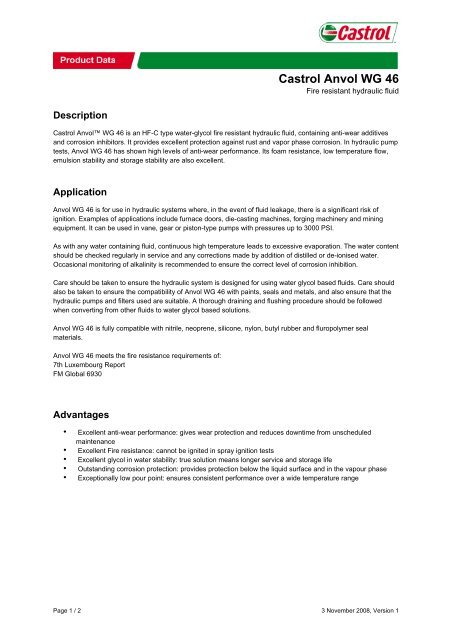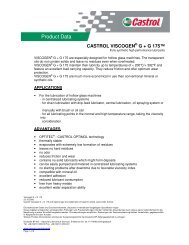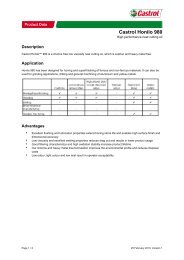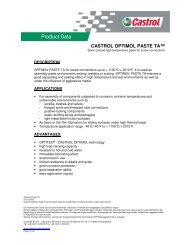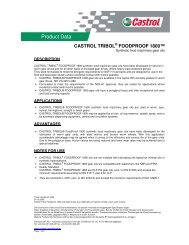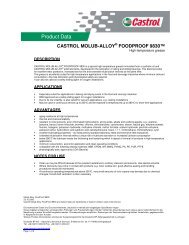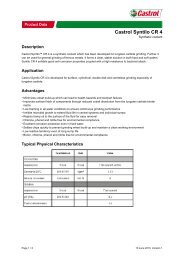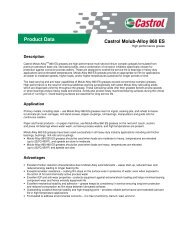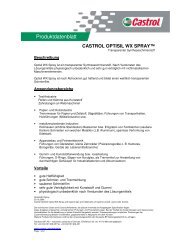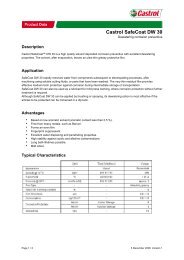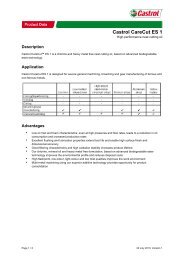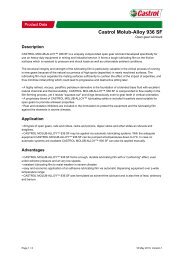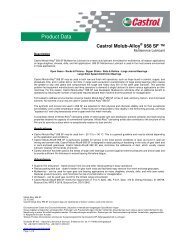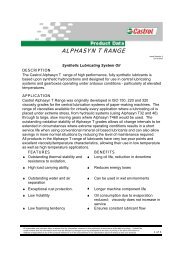Castrol Anvol WG 46
Castrol Anvol WG 46
Castrol Anvol WG 46
You also want an ePaper? Increase the reach of your titles
YUMPU automatically turns print PDFs into web optimized ePapers that Google loves.
<strong>Castrol</strong> <strong>Anvol</strong> <strong>WG</strong> <strong>46</strong><br />
Fire resistant hydraulic fluid<br />
Description<br />
<strong>Castrol</strong> <strong>Anvol</strong> <strong>WG</strong> <strong>46</strong> is an HF-C type water-glycol fire resistant hydraulic fluid, containing anti-wear additives<br />
and corrosion inhibitors. It provides excellent protection against rust and vapor phase corrosion. In hydraulic pump<br />
tests, <strong>Anvol</strong> <strong>WG</strong> <strong>46</strong> has shown high levels of anti-wear performance. Its foam resistance, low temperature flow,<br />
emulsion stability and storage stability are also excellent.<br />
Application<br />
<strong>Anvol</strong> <strong>WG</strong> <strong>46</strong> is for use in hydraulic systems where, in the event of fluid leakage, there is a significant risk of<br />
ignition. Examples of applications include furnace doors, die-casting machines, forging machinery and mining<br />
equipment. It can be used in vane, gear or piston-type pumps with pressures up to 3000 PSI.<br />
As with any water containing fluid, continuous high temperature leads to excessive evaporation. The water content<br />
should be checked regularly in service and any corrections made by addition of distilled or de-ionised water.<br />
Occasional monitoring of alkalinity is recommended to ensure the correct level of corrosion inhibition.<br />
Care should be taken to ensure the hydraulic system is designed for using water glycol based fluids. Care should<br />
also be taken to ensure the compatibility of <strong>Anvol</strong> <strong>WG</strong> <strong>46</strong> with paints, seals and metals, and also ensure that the<br />
hydraulic pumps and filters used are suitable. A thorough draining and flushing procedure should be followed<br />
when converting from other fluids to water glycol based solutions.<br />
<strong>Anvol</strong> <strong>WG</strong> <strong>46</strong> is fully compatible with nitrile, neoprene, silicone, nylon, butyl rubber and fluropolymer seal<br />
materials.<br />
<strong>Anvol</strong> <strong>WG</strong> <strong>46</strong> meets the fire resistance requirements of:<br />
7th Luxembourg Report<br />
FM Global 6930<br />
Advantages<br />
• Excellent anti-wear performance: gives wear protection and reduces downtime from unscheduled<br />
maintenance<br />
• Excellent Fire resistance: cannot be ignited in spray ignition tests<br />
• Excellent glycol in water stability: true solution means longer service and storage life<br />
• Outstanding corrosion protection: provides protection below the liquid surface and in the vapour phase<br />
• Exceptionally low pour point: ensures consistent performance over a wide temperature range<br />
Page 1 / 2 3 November 2008, Version 1
Typical Characteristics<br />
Subject to usual manufacturing tolerances.<br />
Additional Information<br />
Compatibility of <strong>Anvol</strong> <strong>WG</strong> <strong>46</strong> with hydraulic components:<br />
Metals – Compatible with all common metals and passes the corrosion tests for Type HF-C fluids as detailed in<br />
the SHCMOEI Seventh Luxembourg Report.<br />
Seal materials – Suitable materials are: Nitrile PTFE, Neoprene (Chloroprene) Silicone, Viton Nylon, Natural<br />
Rubber Butyl Rubber.<br />
Filters – Most metal types are compatible, but some paper elements can be damaged by water and only types<br />
approved for high water content fluids should be used.<br />
Paints – Fire resistant water glycols soften and lift most paints. Vinyl or epoxy resin based are compatible. When<br />
changing from mineral oil to water-glycol, all paint in the system should be removed unless it is know to be a<br />
compatible type.<br />
Fluid maintenance:<br />
In service water can be lost by evaporation and this must be periodically replaced to maintain the correct viscosity<br />
and optimum fire resistance. Water content can be determined directly by Laboratory analysis. Only condensate,<br />
distilled or de-ionised water should be used for top-up. The required quantity of water should be slowly added to<br />
the reservoir with the system running to ensure thorough mixing.<br />
Operating temperature range:<br />
From -20 to +60°C. <strong>Anvol</strong> <strong>WG</strong> will remain fluid down to approx -50°C, however, the increased viscosity will limit<br />
actual low temperature running. Care must be taken at temperatures above 60°C so water evaporation does not<br />
occur too readily and reduce fire resistant properties.<br />
<strong>Castrol</strong>, <strong>Anvol</strong>, and the <strong>Castrol</strong> logo are trademarks of <strong>Castrol</strong> Limited, used under licence<br />
INTERNATIONAL All reasonable care has been taken to ensure that the information contained in this publication is accurate as<br />
of the date of printing. However, such information may, nevertheless, be affected by changes in the blend formulation occurring<br />
subsequent to the date of printing. Material Safety Data Sheets are available for all <strong>Castrol</strong> Ltd products. The MSDS must be<br />
consulted for appropriate information regarding storage, safe handling and disposal of a product.<br />
<strong>Castrol</strong> Limited, Pipers Way, Swindon, Wiltshire SN3 1RE, UK<br />
www.castrol.com/industrial<br />
<strong>Castrol</strong> <strong>Anvol</strong> <strong>WG</strong> <strong>46</strong><br />
Page 2 / 2 3 November 2008, Version 1


